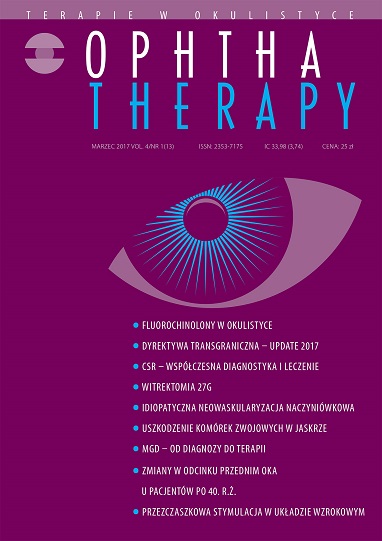Skuteczność ranibizumabu w idiopatycznej neowaskularyzacji naczyniówkowej – opis serii przypadków
##plugins.themes.bootstrap3.article.main##
Abstrakt
Cel: Ocena skuteczności iniekcji ranibizumabu w idiopatycznej neowaskularyzacji naczyniówkowej.
Materiał i metody: Do badania włączono 3 pacjentów (4 oczu) w wieku 17, 37 i 46 lat z objawami pogorszenia ostrości widzenia, krzywieniem i ze zniekształceniem obrazu w centrum trwającym 2–5 tygodni. Wykluczono tło zapalne zmian. Podczas pierwszej wizyty przed włączeniem do badania, po miesiącu i na kolejnych wizytach oceniano najlepiej skorygowaną ostrość wzroku, angiografię fluoresceinową i centralną grubość siatkówki przy użyciu optycznej koherentnej tomografii. Po ustaleniu rozpoznania zastosowano iniekcję ranibizumabu do ciała szklistego.
Wyniki: Podczas pierwszej kontroli w 3 oczach stwierdzono poprawę najlepiej skorygowanej ostrości wzroku; w czwartym pozostała ona niezmieniona. W badaniu oftalmoskopowym we wszystkich przypadkach stwierdzono ustąpienie wybroczyn i obrzęku siatkówki w plamce. W badaniu optycznej koherentnej tomografii siatkówki we wszystkich oczach centralna grubość siatkówki zmniejszyła się z wyraźną poprawą morfologii dołeczka. Obserwacja trwała 4–55 miesięcy, liczba powtórnych iniekcji w tym okresie wynosiła 2–5.
Pobrania
##plugins.themes.bootstrap3.article.details##

Utwór dostępny jest na licencji Creative Commons Uznanie autorstwa – Użycie niekomercyjne – Bez utworów zależnych 4.0 Międzynarodowe.
Copyright: © Medical Education sp. z o.o. License allowing third parties to copy and redistribute the material in any medium or format and to remix, transform, and build upon the material, provided the original work is properly cited and states its license.
Address reprint requests to: Medical Education, Marcin Kuźma (marcin.kuzma@mededu.pl)
Bibliografia
2. Cohen SY, Laroche A, Leguen Y et al. Etiology of choroidal neovascularization in young patients. Ophthalmology. 1996; 103(8): 1241-4.
3. Green WR, Wilson DJ. Choroidal neovascularization. Ophthalmology. 1986; 93(9): 1169-76.
4. Ho AC, Yannuzzi LA, Pisicano K et al. The natural history of idiopathic subfoveal choroidal neovascularization. Ophthalmology. 1995; 102(5): 782-9.
5. Poliner LS, Olk RJ, Burgess D et al. Natural history of retinal pigment epithelial detachments in age related macular degeneration. Ophthalmology. 1986; 93(5): 543-51.
6. Yoo MH, Boo HD, Kim HK. Result of photodynamic therapy for idiopathic subfoveal choroidal neovascularization. Korean J Ophthalmology. 2005; 19(4): 264-8.
7. Kang HM, Koh HJ. Intravitreal anti-vascular endothelial growth factor therapy versus photodynamic therapy for idiopathic choroidal neovascularization. Am J Ophthalmol. 2013; 155(4): 713-9.
8. Kim H, Lee K, Lee CS et al. Subfoveal choroidal thickness in idiopathic choroidal neovascularization and treatment outcomes after intravitreal bevacizumab therapy. Retina. 2015; 35(3): 481-6.
9. Wang F, Wang W, Yu S et al. Functional recovery after intravitreal bevacizumab treatments for idiopathic choroidal neovascularization in young adults. Retina. 2012; 32(4): 679-86.
10. Fukuchi T, Takahashi K, Ida H et al. Staging of idiopathic choroidal neovascularization by optical coherence tomography. Graefes Arch Clin Exp Ophthalmol. 2001; 239(6): 424-9.
11. Shah ASN, Kang QY, Fan XJ et al. Optical coherence tomography characteristics of responses to intravitreal bevacizumab in idiopathic choroidal neovascularisation. Int J Ophthalmol. 2016; 2(9): 271-4.
12. Zhang H, Liu ZL, Sun P et al. Intravitreal bevacizumab for treatment of subfoveal idiopathic choroidal neovascularization: results of a 1-year prospective trial. Am J Ophthalmol. 2012; 153(2): 300-6.
13. Bloom SM, Singal IP. The outer Bruch membrane layer: a previously undescribed spectral-domain optical coherence tomography finding. Retina. 2011; 31(2): 316-23.
14. Gomi F, Sawa M, Sakaguchi H et al. Efficacy of intravitreal bevacizumab for polypoidal choroidal vasculopathy. Br J Ophthalmol. 2008; 92(1): 70-3.
15. Byun YJ, Lee SJ, Koh HJ. Predictors of response after intravitreal bevacizumab injection for neovascular age related macular degeneration. Jpn J Ophthalmol. 2010; 54(6): 571-7.

